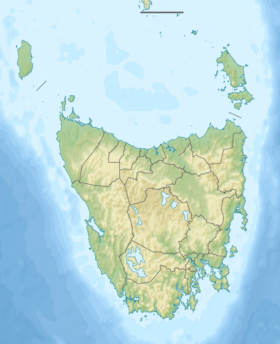New Year Island (Tasmania)
|
New Year Island, located top left, relative to King Island | |
 New Year Island Location of New Year Island in the Great Australian Bight, west of the Bass Strait | |
| Geography | |
|---|---|
| Location | Roaring Forties, Great Australian Bight |
| Coordinates | 39°40′12″S 143°49′12″E / 39.67000°S 143.82000°ECoordinates: 39°40′12″S 143°49′12″E / 39.67000°S 143.82000°E |
| Archipelago | New Year Group |
| Total islands | 5 |
| Major islands | King Island |
| Area | 98.22 ha (242.7 acres) |
| Administration | |
|
Australia | |
| State | Tasmania |
| LGA | Municipality of King Island |
The New Year Island, part of the New Year Group, is a 98.22-hectare (242.7-acre) granite island and game reserve located in the Great Australian Bight, lying off the north-west coast of Tasmania, Australia.[1] While much smaller in area than the adjacent King Island, the New Year Island lends its name to the island group due to its European discovery a few days earlier than the King Island.[2][3]
The island forms part of the King Island Important Bird Area because of its importance for breeding seabirds and waders.[4]
Other islands in the King Island Group include King, Christmas, Little Christmas, and Councillor islands.
Fauna
Breeding seabird and shorebird species include short-tailed shearwater, fairy prion, Pacific gull, silver gull and sooty oystercatcher. Reptiles include tiger snake, white's skink, metallic skink and eastern blue-tongued lizard. A species of mouse is present.[3]
See also
References
- ↑ "New Year Island (TAS)". Gazetteer of Australia online. Geoscience Australia, Australian Government.
- ↑ "Travel: King Island". The Sydney Morning Herald. 8 February 2004. Retrieved 5 July 2016.
- 1 2 Brothers, Nigel; Pemberton, David; Pryor, Helen; Halley, Vanessa (2001). Tasmania’s Offshore Islands: seabirds and other natural features. Hobart: Tasmanian Museum and Art Gallery. pp. 50–51. ISBN 0-7246-4816-X.
- ↑ "King Island". Important Bird Areas factsheet. BirdLife International. 2011. Retrieved 16 July 2011.
